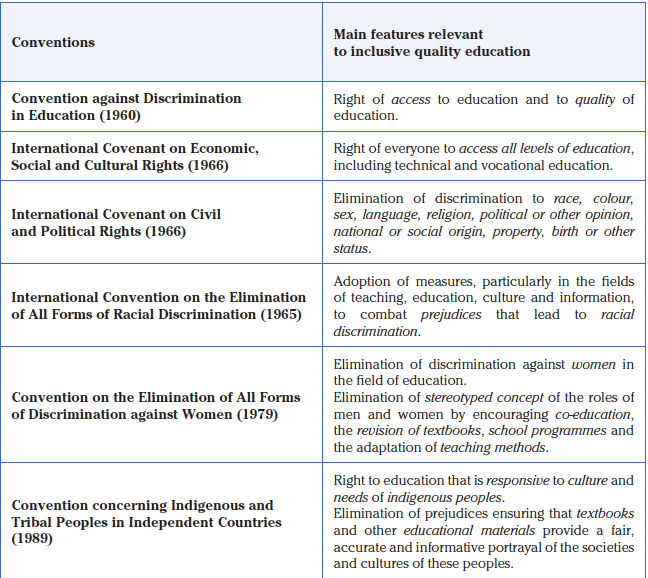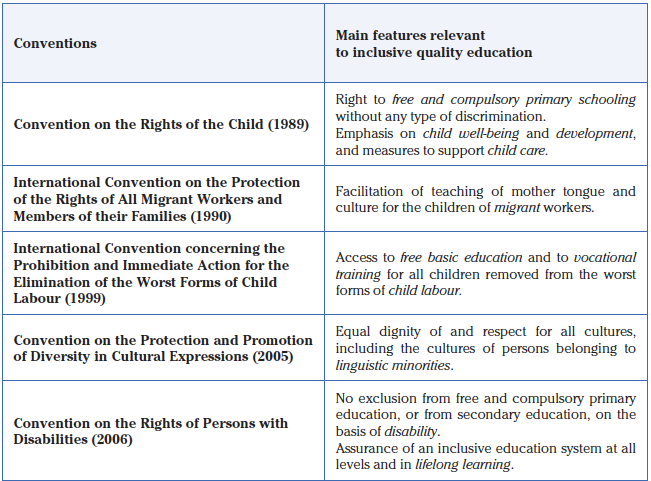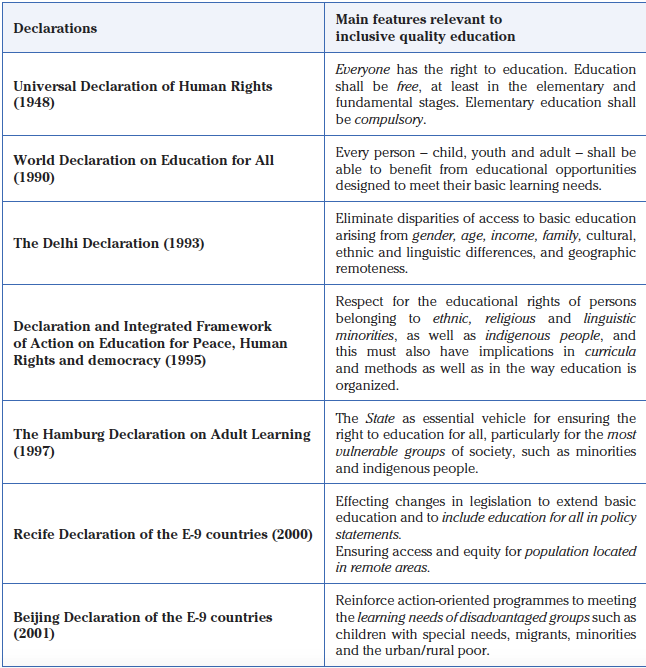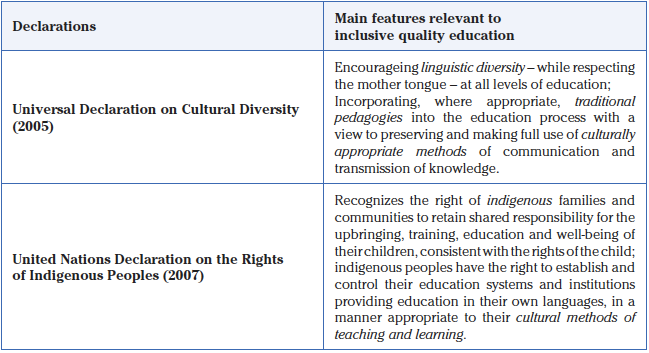Promising policy options
Promote a clear and common understanding of key concepts
In order to create effective policies and legal frameworks, a primary step is to promote a clear and common understanding –among all relevant stakeholders at all levels of the education system– of key terms such as equity, inclusion and inclusive education. For such a purpose, a number of recommendations should be taken into consideration.
Even though each country should create its own context-based definition of the concepts of equity, inclusion and inclusive education, a general understanding can be drawn from international documents such as the Cali Commitment to equity and inclusion in education states, which states that ‘We share the definition of inclusion as a transformative process that ensures full participation and access to quality learning opportunities for all children, young people and adults, respecting and valuing diversity, and eliminating all forms of discrimination in and through education. The term inclusion represents a commitment to making preschools, schools, and other education settings, places in which everyone is valued and belongs, and diversity is seen as enriching.’ (UNESCO, 2019: 1). Through inclusion, particular attention is geared towards groups of learners who, due to their gender, ability, ethnicity, religion, and social class, among others, are marginalised or are at risk of marginalisation (IBE-UNESCO, 2008).
Another important concept is that of the way equity relates to fairness. ‘The education of all learners is seen as being of equal importance’ (UNESCO, 2017: 7). In many countries, the concept is inclusive education is still solely associated with the idea of providing education to children with disabilities within mainstream education settings. In the international arena, on the other hand, this concept has evolved and is understood more broadly as the process of consolidating the capacity of education systems to reach out to all learners and ensure the basic right to high-quality education for all (Ainscow, 2019; IBE-UNESCO, 2008; European Agency for Special Needs and Inclusive Education, 2017; UNESCO, 2009). In that sense, inclusive education involves not only technical changes (such as the modification of curriculum, assessments, pedagogical strategies, etc.) but also philosophical ones (such a set of beliefs which value and welcome diversity) (UNESCO, 2017).
Ministries of education should build consensus around the definition of the concepts of equity, inclusion and inclusive education. Build consensus through a multi-sectoral and multi-level approach by involving all government agencies, ministries, civil society organizations (such as advocacy organizations, Disability Peoples Organisations DPOs), children and youth (particularly those who are marginalised), teachers, teacher educators, teacher unions, families, community members, professional associations, researchers, political and religious leaders, specialist organisations and centres, service providers and local education authorities, among others.
Implement an effective communication strategy through multiple channels to reach the widest extent possible of stakeholders. A number of potential strategies are:
- statements of principles at the governmental level can initiate the debate around inclusion and equity in education;
- recur to ‘champions’. Leaders who mobilise support to inclusive and equitable education systems;
- recur to mass media and conceive a media management strategy. Foster positive attitudes, encourage and welcome diversity, raise social awareness, promote inclusive language, and challenge stereotypes. For example, in Croatia and Montenegro communication campaigns have allowed challenging negative stereotypes and beliefs against persons with disabilities and more generally to raise awareness on the importance of inclusive education; and
- mobilise other channels such as conferences, events, professional journals, social networks, videos. It is recommended to use them to ‘celebrate successes in inclusive education—rather than simply to advocate inclusive education in the abstract’ (IBE-UNESCO, 2008: 15).
European Agency for Special Needs and Inclusive Education. 2017. Inclusive education for learners with disabilities. Study for the Peti committee. Brussels: European Union. Retrieved from: http://www.europarl.europa.eu/RegData/etudes/STUD/2017/596807/IPOL_STU(2017)596807_EN.pdf
IBE-UNESCO (UNESCO International Bureau of Education). 2008. Inclusive education: The Way of the Future, Forty-eight session of the international Conference on Education. Reference document: ED/BIE/CONFINTED 48/3. Geneva: IBE-UNESCO. Retrieved from: http://www.ibe.unesco.org/fileadmin/user_upload/Policy_Dialogue/48th_ICE/CONFINTED_48-3_English.pdf
IBE-UNESCO (UNESCO International Bureau of Education). 2016. Training Tools for Curriculum Development – Reaching Out to All Learners: a Resource Pack for Supporting Inclusive Education. Geneva: IBE-UNESCO. Retrieved from: http://www.ibe.unesco.org/sites/default/files/resources/ibe-crp-inclusiveeducation-2016_eng.pdf
UNESCO. 2009. Policy guidelines on inclusion in education. Paris: UNESCO. Retrieved from: http://unesdoc.unesco.org/images/0017/001778/177849e.pdf.
UNESCO. 2017. A guide for ensuring inclusion and equity in education. Paris: UNESCO. Retrieved from: http://unesdoc.unesco.org/images/0024/002482/248254e.pdf
UNESCO. 2019. Cali commitment to equity and inclusion in education. Forum on inclusion and equity in education – every learner matters, Cali, Colombia, 11-13 September 2019. Retrieved from: https://unesdoc.unesco.org/ark:/48223/pf0000370910
UNICEF (United Nations Children’s Fund). 2014. Legislation and Policies for Inclusive Education: Webinar 3 – Companion Technical Booklet. New York: UNICEF. Retrieved from: https://www.unicef.org/northmacedonia/media/3961/file/MK_InclusiveEducationLegislation_Report_ENG.pdf
UNICEF (United Nations Children’s Fund). 2013. Identifying and Promoting Good Practice in Equity and Child-Friendly Education. New York: UNICEF. Retrieved from: https://www.unicef.org/cfs/files/Identifying_and_Promoting_Good_Practice_in_Equity_and_Child-Friendly_Education.pdf
Review existing policies and legal frameworks
Countries should gain a clear vision of the specific aspects of their education system which should be enhanced to ensure the right to high-quality inclusive education for all. To do so, countries should first perform a diagnosis of the state of equity and inclusion in existent policies, legal frameworks and the education system overall. The following strategies can be implemented for such a purpose (UNESCO, 2017):
- establish a ‘steering committee’. It should be under the lead of the Ministry of Education, have a clear political mandate, and be gender-balanced and representative. Include different stakeholders and representatives from marginalised populations (persons with disabilities, ethnic and religious minorities, etc);
- perform the review through a consultative process. Broad consultations are indispensable to stimulate the debate among a wide range of stakeholders and thus provide a credible assessment. Organise workshops and focus-group discussions, and encourage and empower members from marginalised groups to participate in the consultation process; and
- produce a report which explains the state of equity and inclusion in existent policies and legal frameworks of the education system. Indicate major aspects where equity and inclusion are insufficient. Provide recommendations and guide the development of a clear equity and inclusion action plan.
Multiple tools have been produced to guide this type of review, for more information consult:
- UNESCO. 2017. A guide for ensuring inclusion and equity in education. Paris: UNESCO. Retrieved from: http://unesdoc.unesco.org/images/0024/002482/248254e.pdf
- UNESCO. 2014. The Right to Education: Law and Policy Review Guidelines. Paris: UNESCO. Retrieved from: https://unesdoc.unesco.org/ark:/48223/pf0000228491
- UNESCO. 2009. Policy guidelines on inclusion in education. Paris: UNESCO. Retrieved from: http://unesdoc.unesco.org/images/0017/001778/177849e.pdf.
- Fast Track Initiative. 2010. Equity and Inclusion in Education: A guide to support education sector plan preparation, revision, and appraisal. Retrieved from: https://www.globalpartnership.org/sites/default/files/2010-04-GPE-Equity-and-Inclusion-Guide.pdf
European Agency for Development in Special Needs Education. 2009. Key Principles for Promoting Quality in Inclusive Education Recommendations for Policy Makers. Odense: European Agency for Development in Special Needs Education. Retrieved from: https://www.european-agency.org/sites/default/files/key-principles-for-promoting-quality-in-inclusive-education_key-principles-EN.pdf
IBE-UNESCO (UNESCO International Bureau of Education). 2016. Training Tools for Curriculum Development – Reaching Out to All Learners: a Resource Pack for Supporting Inclusive Education. Geneva: IBE-UNESCO. Retrieved from: http://www.ibe.unesco.org/sites/default/files/resources/ibe-crp-inclusiveeducation-2016_eng.pdf
IIEP-UNESCO Learning Portal. 2019. Brief 3: Disability inclusive education and learning. Accessed 4 November 2019: https://learningportal.iiep.unesco.org/en/issue-briefs/improve-learning/learners-and-support-structures/disability-inclusive-education-and
The World Bank. 2016. SABER what matters most for equity and inclusion in education systems : a framework paper. SABER working paper; no. 10. Washington, D.C. : The World Bank Group. Retrieved form : http://documents.worldbank.org/curated/en/621711500379564153/SABER-what-matters-most-for-equity-and-inclusion-in-education-systems-a-framework-paper
UNESCO. 2017. A guide for ensuring inclusion and equity in education. Paris: UNESCO. Retrieved from: http://unesdoc.unesco.org/images/0024/002482/248254e.pdf
Foster equity and inclusion throughout all educational policies
First, inclusive education should be ‘seen as part of a wider attempt to create a more effective education system’ and thus provide high-quality education to all (IBE-UNESCO, 2008: 13). Building inclusive systems should be part of a comprehensive reform of the education system (the process cannot be taken in isolation or as an additional policy). ‘Inclusive education is difficult to realise where other aspects of the educational and social system remain unreformed and exclusive in their effects’ (IBE-UNESCO, 2008: 13).Thus, it is essential to take into consideration the main aspects of provision, such as: teacher training and distribution, school’s physical infrastructure, curriculum and assessments, pedagogical practices, teaching and learning materials, among others while providing sufficient funds.
(For more information consult Policy pages Equitable teacher distribution; Teacher training; School infrastructure; Equity-sensitive curriculum; Textbook availability and content; Budget allocation and financial incentives).
In addition, decision-makers and education planners should keep in mind that policies found effective in addressing the challenges faced by the ‘average’ will not always be effective in addressing the challenges faced by marginalized groups (IIEP-UNESCO, 2018). Since educational disparity can be influenced and corrected by policies, ‘education policies and approaches need to work with the poorest (or those with lowest learning achievement as proxied by various assessments)’ and this may imply ‘a different approach from that used with the middle or the top of the pyramid’ (IIEP-UNESCO, 2018: 58). As explained by Van Damme, to reach SDG4, it is essential that no one is left behind, and thus working on averages will not suffice (IIEP-UNESCO, 2018). Policy-makers must ensure that the distribution in learning gaps shrinks, especially for those at the bottom (IIEP-UNESCO, 2018).
Finally, it is key to involve multiple stakeholders. Build genuine partnerships between the national government, different ministries, national and international organisations, local and school educational authorities, families and communities, teachers and teacher educators, students, specialised centres and specialists, among many others. Ensure the participation of vulnerable groups so that they can have a say on education policy reform (IIEP-UNESCO, 2018). In addition, school-to-school collaboration should be enhanced.
Second, equity and inclusion must be understood as ‘overarching principles that guide all educational policies, plans, and practices, rather than being the focus of a separate policy’ (UNESCO, 2017: 18). The right to free public education should be ensured for all. The central message guiding policy should be that ‘every learner matters and matters equally’ (UNESCO, 2017: 12). (When the private sector is involved, States must regulate their involvement to ensure that the right to education is respected (The Abidjan Principles, 2019).).
The focus should be geared towards those who are particularly vulnerable to any form of exclusion as well as to contextual barriers that limit the access, participation, and learning of many individuals within the education systems, instead of focusing on what certain individuals lack (Ainscow, 2019). Educational policies and plans should reflect international commitments.
Third, goals, objectives, targets, and indicators which guide national educational plans should aim to enhance equity and inclusion. In general, political will, efficient mobilisation of resources, clear responsibilities, adequate funding, and infrastructure are of utmost importance to ensure that the education policies and plans will provide the desired outcomes (Lewin, 2015; IIEP-UNESCO, 2018).
Goals should define the vision for future educational provision. They should be clear and consensual, and they ought to involve multiple stakeholders in the process (involve marginalised populations throughout the decision-making process). Within these goals, objectives ‘must be specific (i.e. clearly specified with action verbs, subjects, and defined terms), measurable (either directly or by a proxy), achievable (since unattainable goals have little credibility), relevant (i.e. serving a valued purpose), and time-bound (objectives without a timeframe are not very useful).’ (Lewin, 2015: 103). Furthermore, targets should provide milestones to attain the objectives. They introduce accountability by providing ‘benchmarks against which the performance of Ministries of Education can be judged’ (The World Bank, 2016: 18). Finally, indicators must allow policy-makers and planners to measure and monitor progress (for more information consult Policy page Use of data).
(For precise information on long-term planning, consult Lewin, 2015).
IBE-UNESCO (UNESCO International Bureau of Education). 2016. Training Tools for Curriculum Development – Reaching Out to All Learners: a Resource Pack for Supporting Inclusive Education. Geneva: IBE-UNESCO. Retrieved from: http://www.ibe.unesco.org/sites/default/files/resources/ibe-crp-inclusiveeducation-2016_eng.pdf
IIEP-UNESCO. 2018. Learning at the Bottom of the Pyramid: Science, Measurement, and Policy in Low-Income Countries. Paris: IIEP-UNESCO. Retrieved from: https://unesdoc.unesco.org/ark:/48223/pf0000265581
IIEP-UNESCO Learning Portal. 2019. Brief 3: Disability inclusive education and learning. Accessed 4 November 2019: https://learningportal.iiep.unesco.org/en/issue-briefs/improve-learning/learners-and-support-structures/disability-inclusive-education-and
Lewin, K.M. 2015. Educational access, equity, and development: Planning to make rights realities. Fundamentals of Educational Planning. Paris: IIEP-UNESCO. Retrieved from: https://unesdoc.unesco.org/ark:/48223/pf0000235003/PDF/235003eng.pdf.multi
The Abidjan Principles. 2019. The Abidjan Principles on the human rights obligations of States to provide public education and to regulate private involvement in education. Adopted on 13 February 2019. Retrieved from: https://www.abidjanprinciples.org/en/principles/overview
The World Bank. 2016. SABER what matters most for equity and inclusion in education systems : a framework paper. SABER working paper; no. 10. Washington, D.C. : The World Bank Group. Retrieved form : http://documents.worldbank.org/curated/en/621711500379564153/SABER-what-matters-most-for-equity-and-inclusion-in-education-systems-a-framework-paper
UNESCO. 2017. A guide for ensuring inclusion and equity in education. Paris: UNESCO. Retrieved from: http://unesdoc.unesco.org/images/0024/002482/248254e.pdf
Promote a regulatory and legal framework to foster equity and inclusion
In order to ensure equity and inclusion, as well as promote an inclusive education system, regulatory and legal frameworks should be implemented. The following recommendations should be considered:
- Integrate the clear and common definition (see above) of the concepts of equity, inclusion and inclusive education within legal frameworks and make them a priority (e.g. the modification of Article 3 of Mexico’s Constitution made equity a priority in the country (Schmelkes del Valle, Robles Vásquez and Santos del Real, 2022)).
- Articulate principles and rights. Provide an appropriate legal framework to ensure the ‘right to access to education, the right to quality education and the right to respect in the learning environment’ in accordance with international conventions, declarations, and recommendations. For example, the Education 2030 Incheon Declaration and Framework for Action, the UN General Assembly Resolution on the Right to Education in Emergency Situations, among others. For more examples consult Annex 1.) (UNESCO, 2009: 8).
- Mandate indispensable inclusive practices, for instance, state in legal and policy frameworks the obligation for mainstream local schools to educate every child within their community. For instance, the law of 2015 in the Ivory Coast mandates for inclusive education, since then, there has been a significant increase in the enrolment of children with disabilities in regular, mainstream schools (Azoh and Goin Bi, 2022). Ensure an adequate legal provision for procedures and practices which will facilitate equity and inclusion, including supply of accessible teaching and learning materials, learning aids, inclusive and gender-responsive curriculum, among others.
- Reform existent factors which are a major barrier to inclusion. Eliminate ‘all forms of discrimination in the enjoyment of the right to education on grounds such as age, birth, caste, colour, descent, disability, documentation, ethnicity, civil, family or career status, gender identity, health status, or genetic or other predisposition toward illness, language, migration status, national or social origin, nationality, political or other opinion, parental status, pregnancy, property, race, religion, sex, sexual orientation, socio-economic disadvantage, statelessness, or other status’ (The Abidjan Principle, 2019: 13). For example, since 2012 a national measure was adopted in the Ivory Coast to ensure all children without birth certificates enrol in schools (Azoh and Goin Bi, 2022). This measure allowed the enrolment of more than a million children who in previous years were not able to access school due to the lack of birth certificate (Azoh and Goin Bi, 2022).
- Tackle down laws and policies which constitute major barriers to inclusion. For instance, legislation which excludes certain children –especially those with disabilities, displaced populations, pregnant girls– from accessing regular schools. For example, an administrative provision was adopted in 2010 in the Ivory Coast to ensure the retention and reintegration of pregnant girls in schools (Azoh and Goin Bi, 2022). Another example are the efforts put in place in Kenya to ensure the inclusion of displaced populations in the national system (Kinyanjui, 2022). Kenya signed in 2017 Djibouti Declaration and adopted the Comprehensive National Education Sector Plan 2019: Refugee Response Framework (CRRF).
- Provide a unified legislative framework. In many countries, special and regular education systems are covered by different legislative frameworks. It is recommended to merge them into a unified legislative framework (UNESCO, 2017).
Conventions, declarations, and recommendations related to inclusive education (up to 2007)






Source: UNESCO. 2009. Policy guidelines on inclusion in education. Annex 3 pp. 29-32. Paris: UNESCO. Retrieved from: http://unesdoc.unesco.org/images/0017/001778/177849e.pdf.
European Agency for Special Needs and Inclusive Education. 2018. Analysis Framework for Mapping Inclusive Education Policies. Odense: European Agency for Special Needs and Inclusive Education. Retrieved from: https://www.european-agency.org/sites/default/files/analysis_framework_for_mapping_inclusive_education_policies.pdf
IBE-UNESCO (UNESCO International Bureau of Education). 2008. Inclusive education: The Way of the Future, Forty-eight session of the international Conference on Education. Reference document: ED/BIE/CONFINTED 48/3. Geneva: IBE-UNESCO. Retrieved from: http://www.ibe.unesco.org/fileadmin/user_upload/Policy_Dialogue/48th_ICE/CONFINTED_48-3_English.pdf
Inclusion International. n.d. FAQs – Frequently Asked Questions: Questions You Have About Inclusive Education But Didn’t Know Whom To Ask. Accessed 4 November 2019: https://inclusion-international.org/catalyst-for-inclusive-education/faq/#_ftn2
Kinyanjui, J. 2022. ‘17. Kenya: Education in Marginalized Communities’. In: D.A. Wagner, N.M. Castillo and S. Grant Lewis (Eds), Learning, Marginalization, and Improving the Quality of Education in Low-income Countries, (pp. 417-438). Cambridge, UK: Open Book Publishers. Retrieved from: https://doi.org/10.11647/OBP.0256
Schmelkes del Valle, S.; Robles Vásquez, H.; Santos del Real, A. 2022. ‘8. Mexico: Education and Learning at the Bottom of the Pyramid’. In: D.A. Wagner, N.M. Castillo and S. Grant Lewis (Eds), Learning, Marginalization, and Improving the Quality of Education in Low-income Countries, (pp. 223-276). Cambridge, UK: Open Book Publishers. Retrieved from: https://doi.org/10.11647/OBP.0256
The Abidjan Principles. 2019. The Abidjan Principles on the human rights obligations of States to provide public education and to regulate private involvement in education. Adopted on 13 February 2019. Retrieved from: https://www.abidjanprinciples.org/en/principles/overview
The World Bank. 2016. SABER what matters most for equity and inclusion in education systems : a framework paper. SABER working paper; no. 10. Washington, D.C. : The World Bank Group. Retrieved form : http://documents.worldbank.org/curated/en/621711500379564153/SABER-what-matters-most-for-equity-and-inclusion-in-education-systems-a-framework-paper
UNESCO. 2009. Policy guidelines on inclusion in education. Paris: UNESCO. Retrieved from: http://unesdoc.unesco.org/images/0017/001778/177849e.pdf.
UNESCO. 2017. A guide for ensuring inclusion and equity in education. Paris: UNESCO. Retrieved from: http://unesdoc.unesco.org/images/0024/002482/248254e.pdf
UNICEF (United Nations Children’s Fund). 2014. Legislation and Policies for Inclusive Education: Webinar 3 – Companion Technical Booklet. New York: UNICEF. Retrieved from: https://www.unicef.org/northmacedonia/media/3961/file/MK_InclusiveEducationLegislation_Report_ENG.pdf
